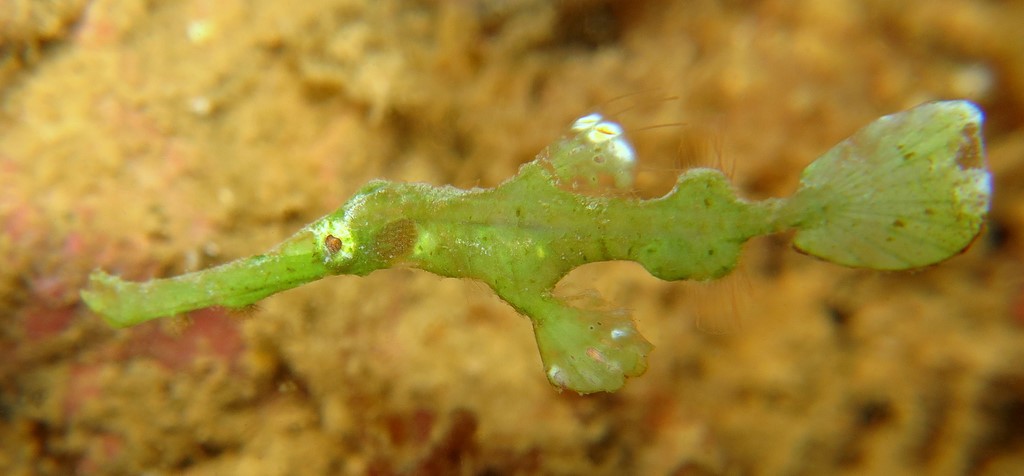SOLENOSTOMUS HALIMEDA - (ORR, FRITZSCHE & RANDALL, 2002)
Picture courtesy of: Alain Daoulas
Actinopterygii (Gigaclass) > Actinopteri (Class) > Teleostei (Subclass) > Syngnathiformes (Order) > Syngnathoidei (Suborder) > Solenostomidae (Family) > Solenostomus (Genus)Poisson-fantôme halimeda, Poissons-aiguilles fantômes halimeda, Halimeda Ghostpipefish, Algae ghostpipefish, Coralline ghostpipefish,
Description
Dorsal spines (total): 5; Dorsal soft rays (total): 16-18 (usually: 17); Anal soft rays: 17-19 (usually: 17); Pectoral fin rays: 22-25 (usually: 22-23); Pelvic fin rays: I, 6; Caudal fin rays: 16; Vertebrae: 32 (19+13); Body depth: 17.0-29.9 (usually: 20.3) % SL; Head length: 45.3-52.5 (usually: 50.3) % SL; Snout length: 30.1-36.7 (usually: 34.3) % SL; Greatest snout depth: 9.9-12.6 (usually: 11.9) % HL; Least snout depth 9.3-11.1. (usually: 9.3) % HL; Head and body elongate, laterally compressed, encased in a series of bony plates; Snout, long, tubular snout; Olfactory rosette sexually dimorphic, females with small dorsal patch of 3-5 lamellae, males with larger patch with 15 lamellae; Caudal peduncle short; Abdominal spinules few to numerous; Cutaneous papillae always present at midpoint of snout. Two widely separate dorsal fins, the first spinous and elongate, second rounded and composed of unbranched rays; Pelvic fins expanded and elongate, united to form a brood pouch in females; Caudal fin short, truncate or slightly rounded; Fin membranes entire. Max. length: 7.0 cm TL. Depth range: 1 - 23 m.
Color
Usually greyish or green in color, usually resembling the coralline alga Halimeda, often with darker speckling and white mottling; Dermal papillae red; Dark blotches often present on each interspinal membrane between 1st and 3rd dorsal fin spines. Halimeda Ghostpipefish are able to change color to match their surroundings.
Etymology
Solenostomus: from Greek, solen-o = tube + from Greek, stoma = mouth. Referring to small mouth at end of long, compressed tube.
halimeda: named for resemblance to Halimeda, a genus of marine algae, especially greenish coloration and rounded shapes of spinous dorsal, pelvic and caudal fins.
Original description: Solenostomus halimeda Orr, Fritzsche & Randall, 2002 - Type locality: Mermaid Reef, Central Lagoon, Rowley Shoals, Western Australia, 17°06'S, 119°37'E, 26 July 1982, G. R. Allen, female with eggs.
Distribution
Indo-West Pacific: Maldives east to Marshall Islands and New Ireland (Papua New Guinea), south to Western Australia and New Caledonia.
Biology
Found in coral reef of inshore waters. Benthic species. Often among Halimeda or coralline algae, which it greatly resembles. Feed on tiny crustaceans, especially mysids, which are rapidly sucked in through the long tubular snout. Ghostpipefish are ambush predators, and stealthily appraoch their prey in a head-down position. Females brood their eggs in a special pouch (marsupium) formed from the united pelvic fins. The well-developed larvae hatch at approximately 3 mm with pigmented eyes, a fully formed mouth and advanced body spination. Although of interest to aquarists, ghost pipefish are very difficult to maintain in captivity.
Similar Species
Solenostomus cyanopterus (Bleeker, 1854) - Reported from New Caledonia - Link to the species (here) - Solenostomus halimeda is most similar to Solenostomus cyanopterus, differing in having a more slender snout, abdominal prickles, and in lacking a premaxillary spine in males.
Last update: 30, July 2022
